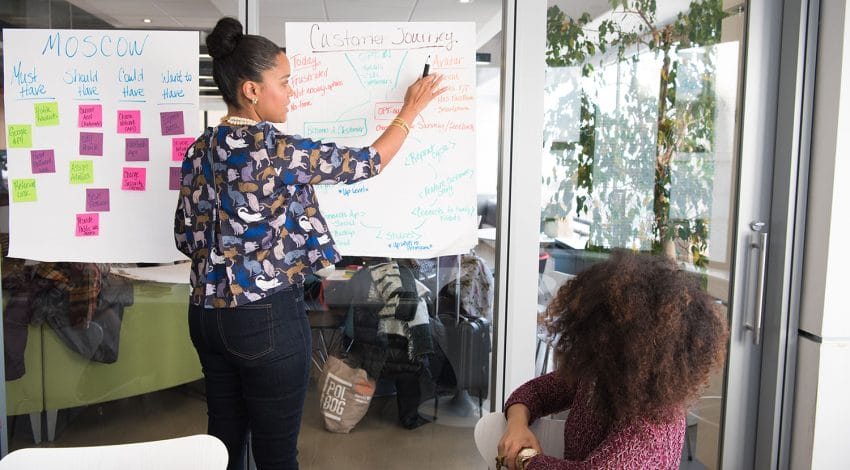In traditional training approaches, 85 percent of the organization’s effort takes place during a single, one-and-done event. Only five percent of the effort and resources are devoted to follow-up after the “event.”
For training to stick, here’s our recommended approach for where to place your time and energy:
- Culture-specific pre-work before training – 25%
- Focused training – 25%
- Coaching and feedback after training – 25%
- Recognition, standards, and connection to purpose – 25%
To achieve this balanced approach, you must be carefully plan training to be effective. When I look at organizations with the highest success rate for making training stick, they all have one thing in common. They plan for how they will weave the training into the fabric of the organization. It doesn’t matter whether it’s customer service training or adapting to a new computer system. The new skills need to become a way of life at the organization.
Here are our four keys to making it stick.
Start With the Leadership
Connecting leadership is key to success. Help staff understand why the training is needed, how it will take place, and what will be taught. Leaders should see the entire program that the front line will be trained on. They should be prepared to reinforce the training immediately after it occurs. Leaders should also be prepared to coach and mentor staff about the program so they can help make it stick. You won’t gain the necessary traction in the culture, if leaders aren’t fully on board or aren’t prepared to effectively coach.
A practice we like to incorporate with leaders is identifying tough situations or questions that staff may face. Leaders often need to discuss how they will handle resistance. We coach them to walk through these situations. Preparing for these “what if” scenarios upfront. It will help leaders gain focus. The act of “rehearsing” a response prepares them for potentially real situations that may emerge. It helps them to stay on message with confidence.
Practice Makes Perfect
Skill building is best done with live practice in an interactive manner and in an environment where attendees can get feedback. In a digital world, we’re often quick to assume that doing everything online is best. When it comes to this type of training, though, that’s not the case. Remember, we’re in a service-oriented, people-centered, business. We interact with patients when they are at their most vulnerable. To manage the interactions effectively, we need to practice, in person, with real people. We need to become adept at reading nonverbal cues. We need to practice giving and receiving feedback. That doesn’t happen online. We all learn best by doing.
Make it Personal
Sharing personal stories and personal reflections helps to make the training stick. During our busy days, it’s easy for new skills to get swept aside for familiar routines, but connection to purpose will make your training memorable and give it a sense of importance. Stories help make that connection to purpose.
In addition to helping leaders to build their storytelling skills, we give attendees a challenge. We ask them to think of one thing that they are going to do differently after the training. We also tell them that their unit leader is going to be asking them about that personal commitment. Making it personal takes the training from the head to the heart and hands. It moves them from thinking about service concepts, to thinking about how they’re going to put these behaviors into play with the customers they serve. Remember, not all employees have patients, but all of them have customers.
We also encourage all unit managers to speak with staff after they attend the training to learn what change they are working on.
Deliver a Big Dose
Timing can be a challenge when you’re training hundreds or thousands of employees. It can take significant planning and organizing to get everyone through the training. Taking a trickle approach, offering one or two classes at a time, and spreading the training out over several months, risks losing momentum. Focus on getting the training completed in a relatively short period of time. Harness the momentum and create a palpable shift in the organization. This is much more likely when there is a big dose delivered all at once.
A single training session won’t get lasting results. What you must strive for is a culture shift—a culture focused on unwavering accountability for delivering exceptional patient experiences, every day, every time, with every encounter.
Creating a consistently positive customer experience requires training that builds skills but engages staff in a strong connection to purpose. Everyone needs some early wins. When done right, and reinforced by observant leaders, training will support the early win.
On June 1, Baird Group is hosting a Train the Trainer event for our course, The Power of One. This event is a unique opportunity to prepare yourself to lead your organization to success. A special emphasis for this train-the-trainer day is for medical practices. The Power of One: Make Every Encounter Count takes a deep dive into creating a top-notch customer service experience. We have designed this course for staff at all levels and recommend that at least two people from each organization train as trainers. We have limited space and registrations will be on a first-come, first-served basis. Learn more about the training event and sign up today. Call 920-563-4684 or email Hillary@baird-group.com.


